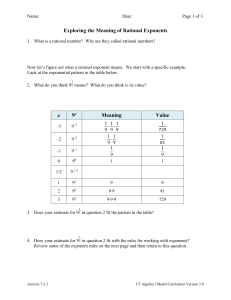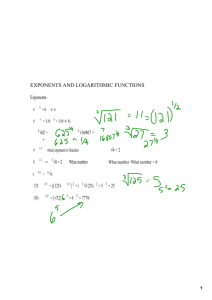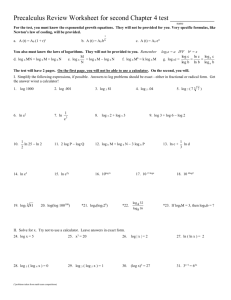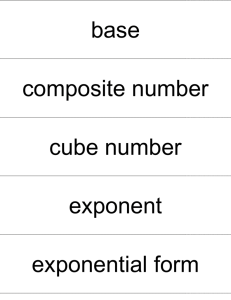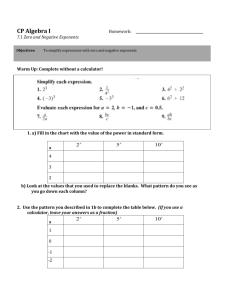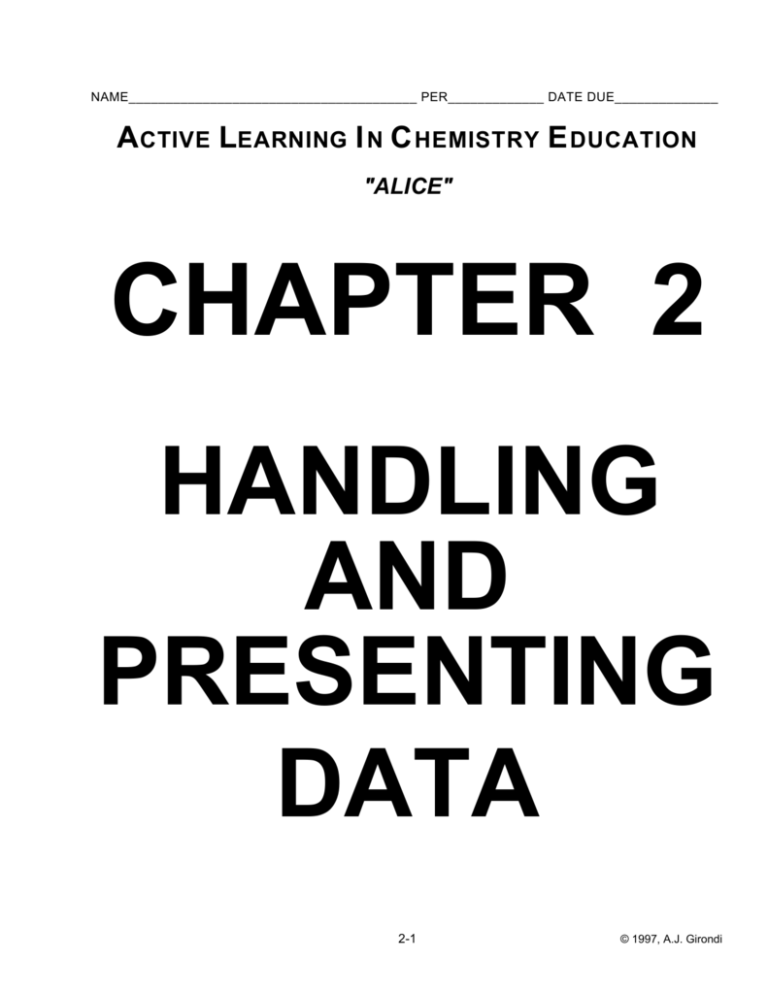
NAME_______________________________________ PER_____________ DATE DUE______________
ACTIVE LEARNING I N C HEMISTRY E DUCATION
"ALICE"
CHAPTER 2
HANDLING
AND
PRESENTING
DATA
2-1
© 1997, A.J. Girondi
NOTICE OF RIGHTS
All rights reserved. No part of this document may be reproduced or transmitted in any form by any means,
electronic, mechanical, photocopying, or otherwise, without the prior written permission of the author.
Copies of this document may be made free of charge for use in public or nonprofit private educational institutions
provided that permission is obtained from the author . Please indicate the name and address of the institution
where use is anticipated.
© 1997 A.J. Girondi, Ph.D.
505 Latshmere Drive
Harrisburg, PA 17109
alicechem@geocities.com
Website: www.geocities.com/Athens/Oracle/2041
2-2
© 1997, A.J. Girondi
SECTION 2.1
Use of Scientific Notation
Much of this chemistry course will deal with experimentation. In chapter 1 you tried many of the more
commonly used laboratory techniques. Being skilled with the laboratory equipment will help you to carry out
experiments more efficiently. Every experiment you perform has a purpose. You are usually trying to answer a
question or to discover some relationship that may exist between variables. The conclusions you draw from
experiments often depend on how you organize your data. This is a very important part of chemistry. As a result,
we are devoting this entire chapter to the handling of data.
When you work with chemistry concepts, you will often be using extremely large or extremely small
numbers. For example, the speed of light is 30,000,000,000 cm per second. The mass of the Earth is
6,000,000,000,000,000,000,000,000 kg. The mass of an electron is very, very small.
In fact it is
0.000,000,000,000,000,000,000,000,000,091 g.
The wavelength of yellow light is about 0.000059 cm.
Numbers expressed in this way are awkward and have little meaning to us. They cannot be quickly comprehended
at first sight. Therefore, a more convenient way to express such numbers is in a form called "exponential
notation."
In exponential notation, numbers are expressed as multiples or powers of ten. Exponential numbers are a
form of what is called "scientific notation." The following examples illustrate how common numbers may be
expressed in exponential notation.
10 = 1 X 101
0.1 = 10 -1
0.001 = 1 X 10-3
0.01 = 1 X 10-2
100 = 1 X 102
10,000 = 1 X 104
123 = 1.23 X 102
1000 = 1 X 103
0.0001 = 1 X 10-4
When writing in scientific notation, there should be only one digit (not a zero) to the left of the decimal point.
The exponent is determined by the number of digits the decimal is moved to get it to the proper position.
For example, 1,300 can also be written as 1.3 X 10 3 - the decimal moves 3 places to the left so the exponent on
the ten is a 3. If we would have had to move the decimal point three places to the right, then the exponent on the
10 would have been a negative three (-3). That is, 0.0013 = 1.3 X 10-3. Notice also that the trailing or leading
zeros in the original numbers are no longer used.
Problem 1. Complete the following by writing the numbers in either exponential form or regular form.
a. 190,000
_______________
b. 1.986 X 105
_______________
c. 528
_______________
d. 1.986 X 108
_______________
e. 4,400,000
_______________
f. 1.75 X 107
_______________
g. 9700
_______________
h. 3.33 X 104
_______________
i. 49
_______________
j. 2.5 X 101
_______________
k. 0.056
_______________
l. 9.28 X 10-8
_______________
m. 0.113
_______________
n. 1.411 X 10-3
_______________
o. 0.00000035 _______________
p. 6.275 X 10-6
_______________
q. 0.00077
r. 2.79 X 10-4
_______________
t. 1.3 X 10-1
_______________
______________
s. 0.00000512 ______________
2-3
© 1997, A.J. Girondi
NOTE! NOTE! NOTE! Check with your teacher at this point to see if you should read and complete the work
on uncertainty in measurement in Appendix A. If so, do that now and then return to section 2.2, and finish this
chapter.
To Appendix A -----> ??????
SECTION 2.2
Calculations Involving Scientific Notation
Using exponential numbers can save you a lot of time when doing calculations. For example, if you were
asked to multiply a number such as 1,400,000 by 3,200, the amount of time spent carrying decimal places would
be considerable. Assuming that you did not have a calculator available, it would take time to complete such a
calculation. You can solve the problem quite easily using exponential notation. The problem would take this form:
(1.40 X 106) X (3.20 X 103) = 4.48 X 109
How was this answer obtained? First multiply the regular numbers by one another, then add the exponents to get
the correct final exponent in the answer. To divide using exponential numbers, you must change the sign of the
exponent in the denominator and add it to the exponent in the numerator.
Example 1:
8.0 X 106
8.0 X 10+6(-3)
=
= 4.0 X 10 3
3
2.0
2.0 X 10
Example 2:
9.0 X 104
= 2.0 X 10+4(+7) = 2.0 X 1011
4.5 X 10-7
You should also try to do these problems using a scientific calculator. The exponent key on most scientific
calculators is designated as the "EXP" key or the "EE" key. In order to enter an exponential number into a
calculator the exponent key is used as follows. To enter 8.6 X 106, you should enter 8.6 then press the exponent
key then enter the exponent. That would be: 8.6 [EE] 6. Notice that you would NOT press the multiplication key
and you would NOT enter the ten. On most calculators, the exponent is shown at the extreme right of the display
and usually without the ten showing (we assume it is there).
Many students get confused about how to solve more complex problems when using a calculator. Let's
try an example:
(5.6 X 103 )(2.4 X 102 )
= 6.4 X 10-4
(5.8 X 10 5)(3.6 X 10 3 )
To solve this problem on a calculator without using any subtotals, simply enter the first number in the numerator
(5.6 X 103), then divide by (5.8 X 105). Now, multiply by (2.4 X 102), and then divide by (3.6 X 103). Calculators are
fussy about the way you enter your data. It is best to alternately multiply and divide such as was done above.
Here is another example:
45
= ??
(32) (88)
If you enter 45 in the calculator, and then divide by the product of 32 and 88 you will get the wrong answer. You
can solve this problem correctly in one of two ways. You can enter 45 in the calculator, then divide by 32, then
multiply by 1, and finally divide by 88. This is the alternating pattern mentioned above. Or, you can enter 45 into
the calculator and then divide by the quantity (32 X 88). This method requires the use of the parentheses found
on scientific calculators. Try it both ways. You should get 0.016 (rounded off).
2-4
© 1997, A.J. Girondi
Problem 2. Practice doing calculations such as those below. You should give each answer in scientific notation.
You may use a calculator to solve these problems, but try doing several of them using only a pencil - just to be sure
you can.
Sample Problem: (7.0 X 1027)(4.0 X 10-10) = 28 X 1027-10 = 28 X 1017 = 2.8 X 1018
a. (4.0 X 1020)(3.0 X 1015) =
b. (9.0 X 1017)(4.0 X 10-4) =
c. (8.0 X 1022)(8.0 X 1022) =
d. (5.0 X 1012)(5.0 X 10-12) =
e. (4.0 X 1015) ÷ (2.0 X 1020) =
f. (3.0 X 10-12) ÷ (3.0 X 10-14) =
g. (7.0 X 106) ÷ (3.5 X 10-10) =
h. (8.2 X 10-20) ÷ (4.1 X 10-20) =
i. (2.88 X 1023) ÷ (2.0 X 1013) =
j.
(3.0 X 1017 )(4.0 X 10-4 )
=
(6 X 10 -5 )
k.
(7.0 X 10-10 )(7.0 X 10 -4 )
=
(7 X 10-14 )
l.
(4.0 X 102 )(4.0 X 106 )
=
(1.6 X 106 )
m.
(3.2 X 101)(6.4 X 101)
=
(1.6 X 103 )
n.
(5.0 X 10 5)(6.0 X 104 )
=
(3.0 X 10 7 )(1.0 X 10 -6 )
o.
(6.4 X 10 4)(7.0 X 103 )
=
(3.2 X 10-4 )(3.5 X 10-3 )
SECTION 2.3
"GuEstimating"
Because it is easy to make an error when entering a number into a calculator, you should estimate (or
"guEstimate") your answer first. In this way, you will be able to quickly recognize any unreasonable answer
obtained with a calculator. For example, suppose we wanted to multiply 6821 by 499. By rounding the numbers
to 7000 and 500 and putting them in exponential form, we get (7 X 103)(5 X 102) = ? It is easy to guesstimate the
answer as 35 X 105 or 3.5 X 106. The actual answer obtained with a calculator is 3,403,679. Our guesstimate
indicates that the answer obtained is, indeed, reasonable. (It is about 3.4 X 106.)
2-5
© 1997, A.J. Girondi
Problem 3. To practice this procedure, solve the problems below. Round off the numbers first, then convert to
exponential form where necessary, then perform the operation and obtain your "guesstimate." (Don't worry about
rounding the GuEstimate properly.) Do all this without the use of a calculator. Finally, use a calculator to obtain the
answer and compare it to your guesstimate.
"GuEstimate"
Calculated Answer
a. (4,851,300 m)(6,200,111 m)
____________________
______________________
b. 80,109 mm 2 ÷ 411 mm
____________________
______________________
c. (0.0000500 cm)(49,850 cm)
____________________
______________________
d. (30,011 km)(299 km)
____________________
______________________
e. (400,102 m)(6.0 X 1023 m) ÷ 310 m
____________________
______________________
SECTION 2.4
Metric Abbreviations and Equivalents
Scientists normally use the metric system to define physical and chemical quantities. In so doing,
abbreviations are used to eliminate the need to write the words defining a unit. The following are the proper
abbreviations for frequently used units of measurement in chemistry. You should study and remember these
units and abbreviations.
Problem 4. After each measure, indicate whether each is a measure of mass, volume, or length. Note which
letters are CAPITALIZED, and which are lowercase.
a. gram (g) ____________
b. milliliter (mL) ____________
c. meter (m) ____________
d. milligrams (mg) ____________
e. millimeter (mm) ___________
f. liter (L) ___________
g. centimeter (cm) ____________
h. kilogram (kg) ____________
i. cubic centimeter (cm3) ____________
You may frequently have to change one metric unit into another. The metric equivalents listed below are
commonly used in chemistry and are needed to make conversions. You will be expected to know them.
1 kg = 1000 g;
1 m = 100 cm;
1 L = 1000 mL;
1 g = 1000 mg;
1 m = 1000 mm;
1 cm = 10 mm
Problem 5. Table 2.1 contains masses of several objects each given in a particular unit of measure. Complete
the table by converting the masses to the units needed to fill in the blanks. Any very small or very large numbers
can be expressed in exponential form. 1 mg = 0.001 g 1 kg = 1000 g
2-6
© 1997, A.J. Girondi
Table 2.1
Object
Mass Conversions
g
mg
kg
small beaker
_____78.96_____
_______________
_______________
pencil
_______________
_____6783_____
_______________
large flask
_______________
_______________
____ 0.378______
SECTION 2.5
Celsius Versus Fahrenheit Temperatures
Another important property that we frequently measure in science is temperature. You have already used
a Celsius thermometer in Chapter 1. The temperature scale that is commonly used in our everyday lives is the
Fahrenheit scale. Because of the way this scale was originally devised, the temperatures 0oF and 100oF are not
equal to the freezing and boiling points of water. Scientists more commonly use the Celsius scale. This scale was
devised by the Swedish astronomer, Anders Celsius, in the early 1700's. The reference point of 0oC is the
temperature at which water freezes, and the 100oC reference point is the temperature at which water boils (both
under standard pressure of 1 atmosphere). If room temperature is taken to be 77 oF, this is then equivalent to
25 oC. There are formulas available to change a temperature in one scale to an equivalent temperature in the
other. However, since Fahrenheit temperatures are rarely ever used in chemistry, we will not do such conversions
here.
SECTION 2.6
Rules for Handling Units During Calculations
Notice that all of the problems which you have completed so far have units as a part of the answer. In
Chapter 1, it was explained that numbers without units are meaningless. Therefore, we must be able to handle
both numbers and their units with efficiency. In fact, your ability to work with units in a chemistry problem will be an
important aid to your success in chemistry. There are two rules that you must use when units are involved in
problems. They are:
1. Only quantities with the same units can be added or subtracted. You cannot add or subtract apples and
oranges.
2. When quantities are multiplied or divided, their units are also multiplied or divided.
To illustrate this, imagine trying to add 50.0 mm Hg to 3.50 atm. Both mm Hg and Atm are units of pressure. We
know that the mathematical sum is 53.5, but what are the units? Are the units "mm Hg" (millimeters of mercury) or
"atm" (atmospheres)? The answer of 53.5 has no meaning because the units on each number are not the same.
Therefore, can we add the pressures in the forms given? No! However, if you know that 1 atm = 760 mm Hg, you
can convert 3.50 atm to mm Hg and add the results to 50.0 mm Hg. This is done for you below.
3.50 atm X
760 mm Hg
=
1 atm
2660 mm Hg
Now use this information to solve problem 6.
2-7
© 1997, A.J. Girondi
Problem 6. 50 mm Hg + 2660 mm Hg =
___________ mm Hg
Suppose we wanted to convert 4.00 hours to seconds. One method of setting up the problem is shown below.
4.00 hr X
60 min
60 sec
X
=
1 hr
1 min
14,400 sec
Notice that all of the units except seconds canceled out.
SECTION 2.7
Dimensional Analysis - A Powerful Way To Solve Problems
Units are a part of all problems. If the units cancel out correctly leaving you only with the units you want in
the answer, you know you have set up the problem correctly. This powerful method of setting up problems is
known as "dimensional analysis" or "unit analysis." Because of the way the set-up of the problem looks on paper,
it is sometimes referred to as a "fencepost."
You are ready to try some sample problems involving units and their cancellation. After you have some
experience with these types of problems, you will realize that you are capable of working many types of problems
without memorizing formulas. Dimensional analysis is not always the shortest way to solve a problem. However, as
problems get more and more complex, dimensional analysis gets more and more powerful because it can guide
you through the logic required, and it allows you to set up large parts of the problem at once, rather than doing a
complicated problem in small parts - one at a time. In addition, you will find that you can solve problems without
knowing anything about the meanings of the terms involved.
Work the following problems. The problems have been partially set up for you. Cancel out units and place
the correct units on your answers. Never express answers as fractions!
Problem 7. If 1 tree = 10 branches, and 15 nests = 15 eggs, and 1 baby bird = 1 egg, and 2 trees = 1 yard, and
5 branches = 5 nests, how many baby birds are there in 1 yard behind a house? (Start with the information given,
1 yard, and solve for baby birds.)
1 yard X
2 trees
10 branches
5 nests
15 eggs
1 baby bird
X
X
X
X
1 yard
1 tree
5 branches
15 nests
1 egg
= ________ baby birds
(Notice how all units cancel except baby birds.)
Problem 8. Two warts = 1 querk, 3 querks = 1 gag, 5 gags = 6 nerfs, and 4 nerfs = 5 wigs. How many warts are
there in 1 wig? Don't panic! You are looking for warts, and you are given wigs. So, we start the fencepost with 1
wig and set up the units so that they cancel and leave you with warts. Finish the set-up below and calculate the
answer.
1 wig X
nerfs
...
wigs
= ______ warts
2-8
© 1997, A.J. Girondi
SECTION 2.8
Use of Complex Units of Measure
A word that we use a lot with units is per. We say miles per gallon (mi/gal) or miles per hour (mi/hr) or grams
per mole (g/mol). These are common units, and they are used in the following problems. Solve these problems
making certain that you show all of your work, including units.
Problem 9. 1.00 case of apples costs $16.00. What is the cost per dozen if a case contains 14.0 dozen apples.
(You want to end with units of $/doz.)
1.00 case
X
14 dozen
=
$
1 dozen
Problem 10. A car travels 300.0 miles on 11.0 gallons of gas. How many miles is the car able to travel when 143
gallons of gas are used? (Be sure to use dimensional analysis.)
143 gal X
= ________ miles
The term "per" can be denoted by a single line. For example, miles per gallon can be written as mi/gal. The term
also gives a clue as to the mathematical process that is involved. Is the process addition, subtraction,
multiplication, or division? {1}___________________________
SECTION 2.9
Practice Problems Involving Units of Measure
The following problems are designed for you to practice canceling out units as they fit into the problems.
Note that singular and plural units that are otherwise the same are considered identical and can cancel each other.
For example, apple can cancel apples.
Problem 11. Indicate for each problem, what units are left after all canceling has been done.
Examples:
L X
a. mole X
b. hrs X
g
mole
mL
= mL
L
sec 2 X
feet
= (sec)(feet)
sec
=
miles
=
hr
c.
feet
sec
min
X
X
=
sec
min
hr
d.
g
mole
X
=
mole
L
2-9
© 1997, A.J. Girondi
e. moles X
mole
=
g
f. moles X
g
=
mole
g. g X
mole
g
X
=
g
mole
h. mole X
mg
L
atm
X
X
=
L
mole
mg
i.
cm 3
m
dm
1
X
X
X
=
m
dm
cm
hec
j.
g
mole
X
=
mole
g
If you can handle numbers and units, you should be able to do problems such as the following example. If
a person can run 100. yards in 10.5 seconds, how fast is he/she running in miles per hour? (1760 yd = 1 mi). First
set up the unit analysis for solving the problem:
yd
mi
sec
min
X
X
X
sec
yd
min
hr
=
mi
hr
Notice how all units cancel except those we wanted to keep in the answer. Substitute the proper numbers and
solve the problem in the space below. See if you get the answer given.
yd
X
sec
mi
X
yd
sec
X
min
min
hr
=
19.5 mi
1.00 hr
Problem 12. Make the following conversions using dimensional analysis. Show your work neatly.
a. Change 400.0 ounces to its comparable figure in tons. (16 ounces = 1 pound, and 2000 pounds = 1 ton.)
b. Calculate the number of seconds in 1.000 week.
c. Convert 2.00 miles to fathoms. (1 fathom = 6 feet; 1 mile = 5280 feet)
2-10
© 1997, A.J. Girondi
d. Change 400. cubic feet per 1.00 second to quarts per minute. (0.265 gallons = 0.0353 ft3; 4 quarts =
1 gallon)
400. ft3
X
1.00 sec
SECTION 2.10
Practice With Dimensional Analysis
Problem 13. Use the information below to solve the problems by unit analysis (dimensional analysis). Some
problems have been started for you.
1 sack = 7 bips; 4 tolls = 3 smacks; 12 tolls = 1 lardo; 5 smacks = 1 bip; 8 lardos = 7 fleas
a. Calculate the number of smacks in 1.00 lardo.
b. Calculate the number of lardos in 1.00 bip.
c. How many sacks are in 1.00 smack?
d. 12 bips equal how many fleas?
2-11
© 1997, A.J. Girondi
e. How many tolls are equivalent to 49 fleas?
Problem 14. Since you will be using the metric system exclusively in chemistry class, you should be able to
convert one metric unit into another. The metric equivalents presented earlier in this chapter are given again
below for your convenience. Solve the problems below using "fenceposting" to set up and solve the problems,
and be sure to SHOW YOUR WORK.
1 kg = 1000 g; 1 m = 100 cm;
1 L = 1000 mL; 1 g = 1000 mg; 1 m = 1000 mm; 1 cm = 10 mm
a. Convert 1.4 kg to g.
b. Convert 896 mL to L
c. Convert 6785 mg to kg
d. Convert 0.458 m to mm
2-12
© 1997, A.J. Girondi
e. Try this one now! Convert 4.5 m3 to cm 3. Hmmmm. This could be tough because you were not given any
relationship between cubic meters (m3) and cubic centimeters (cm3). Therefore, you will need to derive such a
relationship before you can calculate the answer. Do it this way. A scale model of a cubic meter is drawn in the
space below. Since all sides of a cube are equal in length, each side has a length of 1 meter. Now label each
side's length in centimeters. (You will recall that the relationship between meters and centimeters is 1 m = 100
cm.) O.K. Now, since the volume of a cube is s3 where s is the length of a side, you can calculate the volume of
the cube in cubic centimeters. Do that in the space below the box.
Now, complete the following: 1 m3 = ___________________ cm3. You can check your answer by using it in part f
below.
f. Using the relationship you just calculated, you can now convert 4.5 m3 to cm 3. Show the set-up and answer
below.
SECTION 2.11
Practice With Algebra Skills
Chemistry uses a lot of mathematics. But, do not be alarmed! We are going to give you examples of how
to work through the problems, and if you get stuck, you can get plenty of help from your teacher. One of the fun
math forms is algebra. The problems below introduce you to some basic algebra problems. These are the types of
math computations you will use most often in this course.
The first type of algebraic equation you will be using is:
a
c
=
b
d
This equation can be rearranged to solve for a as follows:
a =
cb
d
2-13
© 1997, A.J. Girondi
The equation to solve for b would be:
b =
ad
c
Problem 15. Use your algebra skills to solve the following.
a. Write the equation you would use to solve for c.
b. Write the equation you would use to solve for d.
Another algebraic form you will use is ax + b = cx + d. To solve for x in this equation, begin by moving all x
terms to the left side of the equation: ax - cx = d - b. Factor out the x term: x(a - c) = d - b. Then solve for x by
dividing both sides of the equation by the quantity a - c:
x(a-c)
a-c
=
d-b
a-c
which yields
x =
d-b
a-c
c. Now follow the steps shown above and solve this next problem. Show all of the steps in solving for x.
5x + 2 = 3x + 8
Problem 16. Solve the following problems for x. Show work as well as the answer. Since measurements are
not involved here, do not be concerned about rounding.
a.
8
=
x
4
3
b.
12x
= 24
3
c.
2x + 5
30
=
4 - 2x
12
d. 2x - 3 = 1 - 5x
2-14
© 1997, A.J. Girondi
e. 40(x + 4) = 88
f.
g.
16 x
1
=
4x + 16
2
50.0
2
= 12
SECTION 2.12
Graphing Skills and Terms
You will be collecting data from time to time that will be more easily interpreted in the form of a graph.
There is a correct way to graph data. A well-designed graph should tell the observer a lot about the data collected.
It also includes a descriptive title that describes what the graph is all about. A complete key is a good explanation
that allows viewers to know what data they are looking at. The sample graph below is a plot of data collected from a
laboratory investigation. Note that each set of data has been graphed with a symbol. This allows each set of data
to be easily distinguished from the other. Answer the following questions related to the graph.
What would a good title be for this graph? {2}___________________________________________________
___________________________________________________________________________________
What is the unit used on the vertical, or Y, axis? {3}_______________________________________________
What is the unit used on the horizontal, or X, axis? {4}_____________________________________________
All properly constructed graphs should have equally spaced numbers on both axes. (It is not necessary, however,
to use the same spacing on both axes.) What is the value assigned to each square on the X axis?
{5}_________________
What is the value assigned to each square on the Y axis? {6}____________________
The normal practice to follow when constructing a graph is to place the independent variable on the X axis and the
dependent variable on the Y axis. The independent variable is controlled by the experimenter and the dependent
variable responds accordingly. What variable is being controlled in the graph below? {7}____________________
What is the dependent variable? {8}_______________________
2-15
© 1997, A.J. Girondi
* = situation 1
o = situation 2
x = situation 3
3
*
*
2
Rate of Precipitate
Formation (g/min)
*
1
x
*
x
x
x
*
x
x
x
x
0
5
10
15
20
25
30
35
40
Volume of Sodium Carbonate Used (mL)
Figure 2.1
ACTIVITY 2.13
A Sample Graph
Collecting And Graphing Experimental Data
Before you are given some practice at graphing, it's important to identify two major terms that relate to any
science investigation. They are variable and control. A variable can be defined as something that changes usually a property that is being measured. Unlike a variable, a control does not change and thus, gives us
something with which to compare a variable. To illustrate a variable and a control, get two 250 mL beakers and put
100 mL of tap water in each. Place about 30 g of sodium chloride (table salt) in one beaker and stir until most or all
of the salt is dissolved. (Note that the quantity is about 30 g. This means it does not have to be exact.) Use a
magic marker to label this beaker as the variable. The beaker containing the pure water is the control.
Use two thermometers to measure the initial temperature of the contents of each beaker. In Table 2.2
record these original temperatures at time = 0 sec. Now place four ice cubes in each beaker, start timing and start
stirring. Measure and record the temperature of the contents of each beaker at 30-second intervals (continue
stirring). Record all data in Table 2.2.
What was one thing that was different between your variable and control beakers?
{9}___________________
____________________________________________________________________________________
What was the purpose of the control in this experiment?___________________________________________
____________________________________________________________________________________
2-16
© 1997, A.J. Girondi
Table 2.2
An Experiment Using Variable and Control Factors
Time (sec)
Temp. Water
(variable)
Temp. Water
(control)
0
__________________________________
30
__________________________________
60
__________________________________
90
__________________________________
120
__________________________________
150
__________________________________
180
__________________________________
Keep in mind that the line you draw on a graph does not necessarily have to actually pass through each data point.
The best line may actually pass between the points, depending upon the amount of error in your data. It is usually
better to draw a smoothly flowing line with curves, rather than a choppy one obtained by trying to connect the
points. See the example below.
Figure 2.2 A Smooth Curve
2-17
© 1997, A.J. Girondi
Now graph your data on the blank grid below. Follow the procedures outlined in section 2.13 for
preparing graphs. Remember, a well-designed graph has:
1. a descriptive title
2. independent variable on the X axis; dependent variable on the Y axis
3. both axes labeled correctly, including units
4. a key, if more than one line is plotted on the same graph
5. equally spaced increments on both axes.
2-18
© 1997, A.J. Girondi
ACTIVITY 2.14
Cooling Rates Of Evaporating Liquids
To reinforce your skills in data collecting and graphing, complete this lab activity. Collect the necessary
data and graph the results.
1. Obtain a thermometer and wrap some
cotton (or paper toweling) around the
bulb at the end so that the wrapping is
about as thick as the thermometer itself.
Use a rubber band to secure the
wrapping to the bulb.
Table 2.3
Time Versus Temperature
Time (sec)
Temp. (oC)
0
2. Attach a buret clamp to a ring stand,
and use a piece of string or a paper clip to
hang the thermometer from the clamp.
(See Figure 2.3 below.)
3. Read the temperature of the
thermometer and record this as the
temperature at time zero in Table 2.3.
4. Obtain a bottle of ethyl alcohol which
is at room temperature.
5. Briefly dip the
thermometer into
measuring time
thermometer is
alcohol.
wadded end of the
the alcohol. Begin
as soon as the
removed from the
6. Read the thermometer every 30
seconds and record the temperature in
Table 2.3.
7. Continue this process for five minutes
or until you obtain two temperature
readings which are equal.
Prepare a graph of temperature versus time on the grid on the next page. Remember to place the
independent variable on the horizontal (X) axis.
Figure 2.3
2-19
© 1997, A.J. Girondi
What is the title of your graph? _____________________________________________________________
What is the dependent variable in this experiment? {10}___________________
What is the label for the vertical (Y) axis? {11}_______________________
What is the label for the horizontal (X) axis? {12}_________________________
What is the interval you used on the Y axis? __________X axis?_________
Referring to your data, what data did you collect that would be considered quantitative? {13}_________________
Make a general statement about how the temperature changed with respect to time: ______________________
____________________________________________________________________________________
2-20
© 1997, A.J. Girondi
SECTION 2.15
Learning Outcomes
This chapter was designed to lay the groundwork for future chapters. Review Chapter 2 (and Appendix A
if applicable) carefully and when you are satisfied that you understand the learning outcomes listed below, check
off each one. Arrange to take the quiz or exam on chapter 2.
_____1. Express numbers in scientific notation and back to ordinary form.
_____2. Multiply and divide exponential numbers.
_____3. Use metric units for mass, length, and volume.
_____4. Use dimensional (unit) analysis to solve problems.
_____5. Perform simple algebraic computations.
_____6. Distinguish between variables and controls in an experiment.
_____7. Properly construct and interpret a graph.
You should check the remaining learning outcomes only if you were directed to complete the work in Appendix A.
_____8. Distinguish between those digits in a measurement which are significant and those which are not.
_____9. Express answers to calculations using the correct number of significant digits (also called significant
figures).
2-21
© 1997, A.J. Girondi
SECTION 2.16
Answers to Questions and Problems
Questions:
{1} division; {2} Rate of Precipitate Formation With Respect to Volume of Sodium Carbonate Used;
{3} g/min; {4} mL; {5} 5 mL; {6} 1 g/min; {7} volume; {8} rate; {9} salt is variable & control used for comparison;
{10} temperature; {11} temperature (oC); {12} Time (sec); {13} temperature and time
Problems:
1. a. 1.9 X 105; b. 198,600; c. 5.28 X 102; d. 198,600,000; e. 4.4 X 10 6; f. 17,500,000; g. 9.7 X 103;
h. 33,300; i. 4.9 X 101; j. 25; k. 5.6 X 10-2; l. 0.0000000928; m. 1.13 X 10-1; n. 0.001411;
o. 3.5 X 10-7; p. 0.000006275; q. 7.7 X 10-4; r. 0.000279; s. 5.12 X 10-6; t. 0.13
2. a. 1.2 X 1036; b. 3.6 X 1014; c. 6.4 X 1045; d. 2.5 X 101; e. 2.0 X 10-5; f. 1.0 X 102; g. 2.0 X 1016;
h. 2.0 X 100; i. 1.4 X 1010; j. 2 X 1018; k. 7 X 100; l. 1.0 X 103; m. 1.3 X 100; n. 1.0 X 109; o. 4.0 X 1014
3. a.
b.
c.
d.
e.
GuEstimate:
GuEstimate:
GuEstimate:
GuEstimate:
GuEstimate:
(5 X 106)(6 X 106) = 3 X 1013 m2; Calculated answer: 3.0079 X 1013 m2
(8 X 104 mm) ÷ (4 X 102 mm) = 2 X 102 mm; Calculated answer: 195 mm or 1.95 X 102 mm
(5 X 10-5 cm)(5 X 104 cm) = 2.5 X 100 cm2; Calculated answer: 2.49 cm2
(3 X 104 km)(3 X 102 km) = 9 X 106 km2; Calculated answer: 8.97 X 106 km2
(4 X 105 m)(6 X 1023 m) ÷ (3.00 X 102 m) = 8 X 1026 m; Calculated answer: 7.7 X 1026
4. a. mass; b. volume; c. length; d. mass; e. length; f. volume; g. length; h. mass; i. volume
5. small beaker: 78.96 g, 78,960 mg, 0.07896 kg
pencil: 6.783 g, 6783 mg, 0.006783 kg
large flask: 378 g, 378,000 mg, 0.378 kg
6. 2710 mm Hg
7. 20 baby birds
8. 4 warts
9. $1.14/1 doz
10. 3900 mi.
11. a. g; b. miles;
c. feet/hr;
d. g/L;
e. moles2/g; f. g;
g. g; h. atm; i. cm2/hec; j. 1
12. a. 0.01250 ton; b. 6.048 X 105 sec; c. 1760 fathoms; d. 7.21 X 105 qts/min
13. a. 9.00 smacks; b. 0.556 lardos; c. 0.0286 sacks; d. 5.8 fleas; e. 672 tolls (670 rounded)
14. a. 1400 g; b. 0.896 L; c. 6.785 X 10-3; d. 458 mm; e. 1 X 106 cm3; f. 4.5 X 106 cm3
15. a. c = ad/b; b. d = bc/a; c. x = 3
16. a. x = 6; b. x = 6; c. x = 0.7; d. x = 0.57; e. x = -1.8; f. x = 1.56 g; g. x = 2
2-22
© 1997, A.J. Girondi


